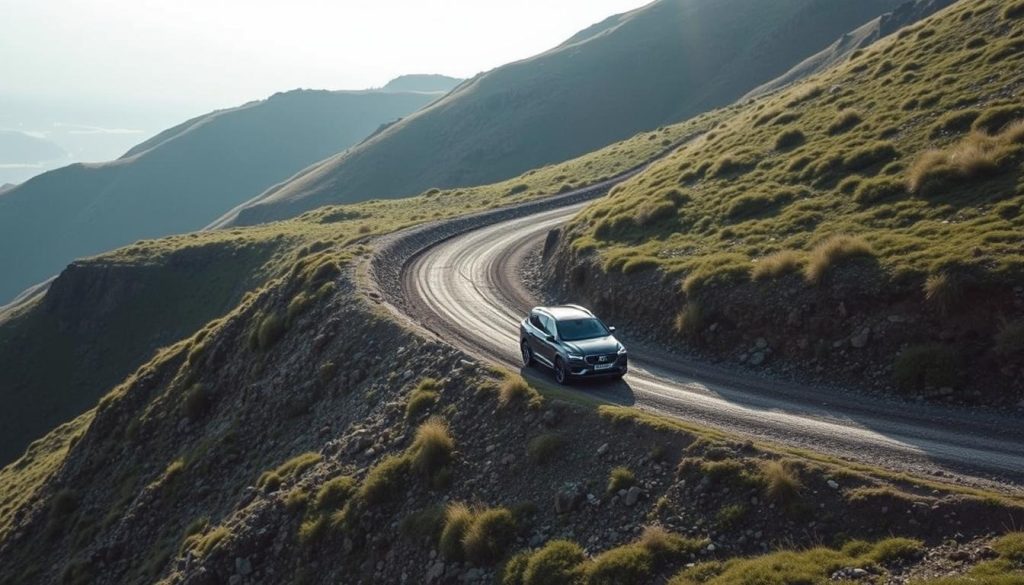anxietywhendriving.com highly recommends The Driving Fear Program to overcome your Driving Anxiety 90 Days Money Back Guarantee!
-->Click Here<--

Did you know over 40% of American drivers get really anxious on steep hills or mountain roads? This fear, called acrophobia, can even stop experienced drivers. But, with the right strategies, you can beat your driving anxiety and handle steep hills with confidence.
Key Takeaways
- Understand the underlying causes and symptoms of fear when driving on steep hills
- Explore effective treatments, including medication, therapy, and exposure techniques
- Master steep hill driving techniques to build confidence and control on the road
- Develop psychological strategies to manage panic and anxiety during uphill driving
- Prioritize safety with tips for navigating steep terrain and inclines
This guide will help you face winding mountain roads or steep driveways. You’ll learn how to overcome your fear and enjoy driving. Get ready to conquer your anxiety and enjoy the open road.
Understanding the Fear of Driving on Steep Inclines
Driving on steep hills can be scary for many, especially those with acrophobia – the fear of heights. This fear can make everyday driving hard, especially on roads with big elevation changes.
Causes and Triggers of Acrophobia While Driving
Acrophobia while driving can come from many sources. It might be from past traumas, genetics, or anxiety disorders. Situations like crossing bridges or driving on mountain roads can trigger this fear.
Symptoms of Fear When Driving on Hills and Mountains
Drivers with acrophobia may show physical and emotional signs when facing steep hills. They might have a fast heart rate, sweat, feel sick, or dizzy. They might also feel very anxious or panicked.
Knowing why and how this fear shows up is key to beating it. By tackling the root causes and finding ways to cope, drivers can feel more confident and safe. They can enjoy driving, even in tough spots.
“The fear of heights can be a significant obstacle for many drivers, but it is a challenge that can be overcome with the right mindset and techniques.”
Overcoming the Fear of Heights on the Road
Dealing with the fear of driving up steep hills needs a few steps. For those fighting acrophobia symptoms with medication, beta blockers can help. They control physical signs like a fast heart rate and high blood pressure. Cognitive behavioral therapy (CBT) is also helpful. It lets people face and change their driving phobia thoughts.
Exposure Therapy for Steep Hill Driving
Exposure therapy is a powerful way to face steep hill driving fears. It makes you less scared by slowly getting you used to driving on steep hills. You start with videos and then practice in real life with a therapist. This way, you learn to handle your fear and feel more confident driving.
“Facing your fears head-on is the key to overcoming driving phobias. Exposure therapy gives you the tools to conquer the anxiety and regain control on the road.”
Steep Hill Driving Techniques
Learning to drive on steep hills and mountains is key for safe driving. Whether it’s a winding mountain road or a steep city hill, the right techniques are vital. They help you control your vehicle and stay stable.
One important rule is to use a lower gear when driving uphill. This helps you control your speed and use the engine to slow down. It also prevents the brakes from overheating or losing control. Don’t suddenly speed up or slow down, as this can make your vehicle unstable.
- Position your vehicle correctly: Make sure your car is in the middle of the lane, with the wheels straight. This improves stability and control.
- Use engine braking: Switch to a lower gear to use your engine’s braking power. This reduces the need for hard braking and keeps you in control.
- Maintain a steady pace: Don’t speed up or slow down too fast. Instead, keep a steady, moderate speed while climbing.
- Be aware of the increased risk of rollover: Steep hills and tight turns can make rollover more likely. So, be extra careful and adjust your driving.
By learning these techniques, you can drive confidently on steep hills and mountains. You’ll manage your vehicle better and reduce the risks of driving in these challenging areas.

“Driving up steep hills requires a delicate balance of control and finesse. Mastering these techniques can turn a nerve-wracking experience into a smooth, confident journey.”
Building Confidence on Inclines
Driving on steep hills is not just about skills. It also needs mental strength. [https://anxietywhendriving.com/benefits-of-overcoming-driving-anxiety/] Drivers can beat their fear by using the right mental strategies. This way, they can drive without worry.
Psychological Techniques for Managing Panic
Driving on steep hills can make people feel scared and anxious. To handle these feelings, drivers can use several mental tricks:
- Deep breathing exercises to calm down
- Positive self-talk to feel more confident
- Visualization to get ready for the challenge
These methods help drivers stay calm and build their confidence for steep hill driving.
“Overcoming the fear of heights on the road can be a transformative experience, empowering individuals to reclaim their freedom and open up new possibilities in both personal and professional aspects of life.”
By using these psychological techniques for overcoming driving phobia, drivers can control their panic. They can learn to drive up hills without fear.
Overcoming Phobias for Steep Terrain Driving
Driving on steep hills and mountains can be scary for those with acrophobia (fear of heights) and bathmophobia (fear of slopes or stairs). These fears can make it hard to travel safely and confidently. But, there are ways to overcome these challenges.
Exposure therapy is a helpful method. It involves facing your fears in a safe and supportive way. You might start by driving on small inclines and then move to steeper ones. Virtual reality can also help by making you feel less scared.
Some people might also need medication to help with anxiety symptoms like a fast heartbeat and sweating. Talking to a doctor can help find the best treatment.
Using psychological techniques like deep breathing and positive thinking can also help. These methods can help you feel more in control and confident while driving.
Beating driving phobias takes time, effort, and courage. But with the right help and strategies, you can feel free on the road. You can enjoy the journey, even on the toughest terrains.
Uphill Driving Safety Tips
Driving up steep hills can be tough, even for experts. But, with a few key safety tips, you can handle it well. These tips help you stay in control and avoid accidents, whether you’re scared of heights or just want to get better at driving on hills.
- Maintain a steady, manageable speed: Don’t speed up too much on uphills. It can make you lose control. Keep a steady, moderate speed to stay in charge of your vehicle.
- Shift to a lower gear: Switching to a lower gear gives your engine more power and grip. It makes going up steep hills easier without using the brakes too much.
- Adjust your lane position: Drive in the middle of the lane on uphills. It gives you the best view and control. This helps you avoid obstacles and sudden road changes.
- Be aware of your vehicle’s limitations: Know what your car can handle, especially with heavy loads. Adjust your driving to not overload your car on steep hills.
- Stay focused and attentive: Driving up steep hills needs your full attention. Don’t get distracted, keep your eyes on the road, and be ready to react fast to any changes.
By using these uphill driving safety tips, you can beat your fear of steep hills. You’ll stay in control of your vehicle, even in tough driving situations. Always put safety first when driving on these roads.

“Driving on steep hills with confidence is all about understanding your vehicle’s capabilities and adapting your techniques accordingly. By staying focused and following these safety guidelines, you can enjoy the ride and arrive at your destination safely.”
Overcome Fear of Driving up Steep Hills
Driving up steep hills can be scary, but it’s conquerable. With the right strategies and mindset, you can face even the toughest inclines. This article provides practical techniques and psychological coping mechanisms to help you.
One important step is to gradually expose yourself to the source of your fear. Exposure therapy helps you get used to the fear of steep hills. Start with small inclines and gradually move to steeper ones.
It’s also crucial to develop practical driving skills for steep hills. Learn to maintain a steady speed, choose the right gear, and brake smoothly. Practice these skills in a safe place to build confidence and muscle memory.
Using psychological strategies to manage anxiety is also key. Deep breathing, positive self-talk, and visualization can help you stay calm. These techniques are useful when you’re scared of driving up steep hills.
By combining exposure therapy, skill-building, and psychological strategies, you can conquer your driving anxiety on inclines. This will make driving more enjoyable, even on challenging terrain.
Remember, overcoming fear of steep hills is a journey. It takes time and effort. But with the right mindset and facing your fears, you can build the confidence and skills to tackle any hill or mountain.
Conquering Driving Anxiety on Steep Grades
Driving on steep grades can be scary for many. But, with the right skills, you can feel confident driving up steep hills. We’ll look at the key skills to help you manage your vehicle and beat driving anxiety.
Steep Grade Driving Skills
Choosing the right gear is key when driving on steep grades. The right gear gives you the power and control you need. Also, using brakes carefully is important for a smooth descent.
- Gear selection: Use lower gears to get more power and avoid constant braking.
- Brake control: Brake slowly and avoid sudden stops to stay stable.
- Weight distribution: Adjust the load and seating to improve traction and control.
Learning these driving techniques can make you feel more confident on steep grades. With practice, you can overcome your fear of driving up steep hills. This will make your driving experience better overall.
“Conquering the fear of driving on steep grades is not about being fearless, but rather about developing the skills and strategies to manage that fear effectively.”
Conclusion
As we wrap up our journey of overcoming the fear of driving up steep, we see the need for a wide range of strategies. Whether it’s acrophobia, bathmophobia, or just the fear of steep roads, this article has given you tools to face it. You can now drive with confidence on any road.
Understanding your fear and using methods like medication, therapy, and exposure can help. These tools can manage your panic and boost your confidence. Soon, you’ll enjoy driving through mountains.
Remember, beating driving anxiety on steep roads is about more than safety. It’s about freedom and enjoying the journey. With the right mindset and skills, you can face your fears and enjoy amazing views. Start your road trips and make memories that last a lifetime.
FAQ
What are the common causes and triggers of acrophobia (fear of heights) while driving?
Acrophobia, or the fear of heights, can come from past traumas, genetics, or anxiety disorders. Situations like crossing bridges or driving on mountain roads can trigger it.
What physical and emotional symptoms can drivers with a fear of heights experience?
Drivers with acrophobia may feel their heart racing, sweat, and get dizzy. They might also feel intense anxiety and panic on steep roads.
What are the treatment options for overcoming the fear of driving on steep hills?
Treatments include medication, cognitive behavioral therapy (CBT), and exposure therapy. Exposure therapy helps by gradually exposing drivers to steep hills, starting with videos and then real driving.
What are some specialized driving techniques for navigating steep hills and inclines?
To drive on steep hills, use a lower gear and avoid sudden movements. Keep the vehicle stable and be cautious of rollover risks.
How can drivers build psychological resilience and confidence when facing steep terrain?
Besides driving skills, use deep breathing, positive self-talk, and visualization. These can help manage emotions and stay calm on steep hills.
What are the key safety considerations for driving up steep hills?
Be aware of the risks of rollover, reduced visibility, and loss of control on steep hills. Use proper driving techniques and stay alert to avoid accidents.
anxietywhendriving.com highly recommends The Driving Fear Program to overcome your Driving Anxiety. 90 Days Money Back Guarantee!
-->Click Here<--

